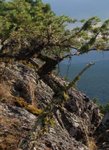Wires_Guy_wires
Imperial Masterpiece
I never said I was good at wiring. Cuz I aint. I already know this.
That's not what this is about. I own this spruce with a lot of potential for an OK looking bonsai in between five and fifty years. It's been out of the woods for a year and a bit, maybe even two, I can't remember honestly.. And it's been putting out a lot of buds. It's never going to be a prize winner but I like it.
Right side on the top was reduced a bit more after I took this picture. But also, that's not what this post is about. It's about the damn stub coming from the telephone pole and sticking out. It used to be a piece of dead wood but with the dropping branch it was messing up the look.
I'd like to remove the stub entirely, but I'm not sure how to go at it. I'm thinking about cutting it in a "/" way following the trunk line (from the top downwards). But that would leave a huge open hole, something that I think will be hard to hide on a spruce like this.
Any advice on the stub would be most welcome.

That's not what this is about. I own this spruce with a lot of potential for an OK looking bonsai in between five and fifty years. It's been out of the woods for a year and a bit, maybe even two, I can't remember honestly.. And it's been putting out a lot of buds. It's never going to be a prize winner but I like it.
Right side on the top was reduced a bit more after I took this picture. But also, that's not what this post is about. It's about the damn stub coming from the telephone pole and sticking out. It used to be a piece of dead wood but with the dropping branch it was messing up the look.
I'd like to remove the stub entirely, but I'm not sure how to go at it. I'm thinking about cutting it in a "/" way following the trunk line (from the top downwards). But that would leave a huge open hole, something that I think will be hard to hide on a spruce like this.
Any advice on the stub would be most welcome.







